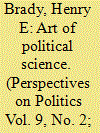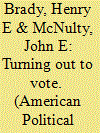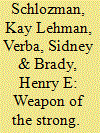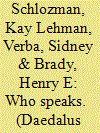|
|
|
Sort Order |
|
|
|
Items / Page
|
|
|
|
|
|
|
| Srl | Item |
| 1 |
ID:
105250


|
|
|
|
|
| Publication |
2011.
|
| Summary/Abstract |
Spatial diagrams of politics could and should be iconic for political science in much the same way as supply-and-demand curves are in economics. Many fundamental problems of political science can be connected with them, and many different concepts-such as ideological constraint, cross-pressures, framing, agenda-setting, political competition, voting systems, and party systems, to name just a few-can be illuminated through spatial diagrams. Spatial diagrams raise questions and provide insights. They suggest political maneuvers, possible realignments, and political problems. They provide us with revealing images that aid memory and facilitate analysis. They are a powerful way to think about politics, and we could not do better than to feature them in our textbooks, to use them in our research, and to exhibit them as our brand-as our distinctive way of thinking about how the world works
|
|
|
|
|
|
|
|
|
|
|
|
|
|
|
|
| 2 |
ID:
105173


|
|
|
|
|
| Publication |
2011.
|
| Summary/Abstract |
Could changing the locations of polling places affect the outcome of an election by increasing the costs of voting for some and decreasing them for others? The consolidation of voting precincts in Los Angeles County during California's 2003 gubernatorial recall election provides a natural experiment for studying how changing polling places influences voter turnout. Overall turnout decreased by a substantial 1.85 percentage points: A drop in polling place turnout of 3.03 percentage points was partially offset by an increase in absentee voting of 1.18 percentage points. Both transportation and search costs caused these changes. Although there is no evidence that the Los Angeles Registrar of Voters changed more polling locations for those registered with one party than for those registered with another, the changing of polling places still had a small partisan effect because those registered as Democrats were more sensitive to changes in costs than those registered as Republicans. The effects were small enough to allay worries about significant electoral consequences in this instance (e.g., the partisan effect might be decisive in only about one in two hundred contested House elections), but large enough to make it possible for someone to affect outcomes by more extensive manipulation of polling place locations.
|
|
|
|
|
|
|
|
|
|
|
|
|
|
|
|
| 3 |
ID:
097629


|
|
|
|
|
| Publication |
2010.
|
| Summary/Abstract |
What is the impact of the possibility of political participation on the Internet on long-standing patterns of participatory inequality in American politics? An August 2008 representative survey of Americans conducted by the Pew Internet and American Life Project provides little evidence that there has been any change in the extent to which political participation is stratified by socio-economic status, but it suggests that the web has ameliorated the well-known participatory deficit among those who have just joined the electorate. Even when only that subset of the population with Internet access is considered, participatory acts such as contributing to candidates, contacting officials, signing a political petition, or communicating with political groups are as stratified socio-economically when done on the web as when done offline. The story is different for stratification by age where historically younger people have been less engaged than older people in most forms of political participation. Young adults are much more likely than their elders to be comfortable with electronic technologies and to use the Internet, but among Internet users, the young are not especially politically active. How these trends play out in the future depends on what happens to the current Web-savvy younger generation and the cohorts that follow and on the rapidly developing political capacities of the Web. Stay logged on …
|
|
|
|
|
|
|
|
|
|
|
|
|
|
|
|
| 4 |
ID:
108869


|
|
|
|
|
| Publication |
2011.
|
| Summary/Abstract |
Using an August 2008 representative survey of Americans conducted by the Pew Internet & American Life Project, we investigate the consequences of Internet-based political activity for long-standing patterns of participatory inequality. There is little evidence of change in the extent to which political participation is stratified by socioeconomic status, even when we account for the fact that the well educated and affluent are more likely to be Internet users. However, because young adults are much more likely than their elders to be comfortable with electronic technologies and to use the Internet, the Web has ameliorated the well-known participatory deficit among those who have recently joined the electorate. Still, among Internet users, the young are not especially politically active. How these trends play out in the future depends on what happens to the current Web-savvy younger generation and the cohorts that follow as well as on the rapidly developing political capacities of the Web.
|
|
|
|
|
|
|
|
|
|
|
|
|
|
|
|
|
|
|
|
|